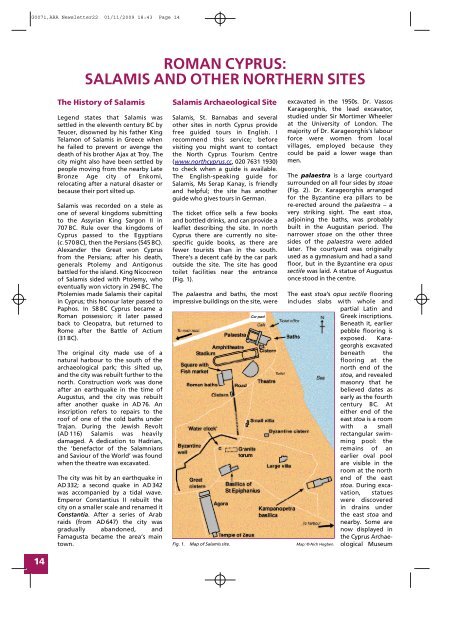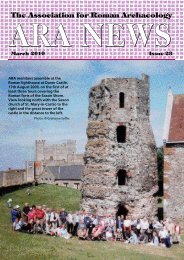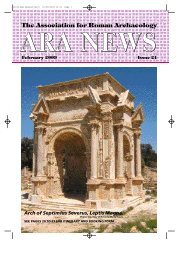Newsletter Issue 22 - Association for Roman Archaeology
Newsletter Issue 22 - Association for Roman Archaeology
Newsletter Issue 22 - Association for Roman Archaeology
Create successful ePaper yourself
Turn your PDF publications into a flip-book with our unique Google optimized e-Paper software.
G0071,ARA <strong>Newsletter</strong><strong>22</strong> 01/11/2009 18:43 Page 14ROMAN CYPRUS:SALAMIS AND OTHER NORTHERN SITESThe History of SalamisLegend states that Salamis wassettled in the eleventh century BC byTeucer, disowned by his father KingTelamon of Salamis in Greece whenhe failed to prevent or avenge thedeath of his brother Ajax at Troy. Thecity might also have been settled bypeople moving from the nearby LateB ronze Age city of Enkomi,relocating after a natural disaster orbecause their port silted up.Salamis was recorded on a stele asone of several kingdoms submittingto the Assyrian King Sargon II in707 BC. Rule over the kingdoms ofC y p rus passed to the Egyptians(c.570 BC), then the Persians (545 BC).Alexander the Great won Cyprusfrom the Persians; after his death,generals Ptolemy and Antigonusbattled <strong>for</strong> the island. King Nicocreonof Salamis sided with Ptolemy, whoeventually won victory in 294 BC. ThePtolemies made Salamis their capitalin Cyprus; this honour later passed toPaphos. In 58 BC Cyprus became a<strong>Roman</strong> possession; it later passedback to Cleopatra, but returned toRome after the Battle of Actium(31 BC).The original city made use of anatural harbour to the south of thearchaeological park; this silted up,and the city was rebuilt further to thenorth. Construction work was doneafter an earthquake in the time ofAugustus, and the city was rebuiltafter another quake in AD 76. Aninscription refers to repairs to theroof of one of the cold baths underTrajan. During the Jewish Revolt( AD 116) Salamis was heavilydamaged. A dedication to Hadrian,the ‘benefactor of the Salamniansand Saviour of the World’ was foundwhen the theatre was excavated.The city was hit by an earthquake inAD332; a second quake in AD342was accompanied by a tidal wave.Emperor Constantius II rebuilt thecity on a smaller scale and renamed itConstantia. After a series of Arabraids (from AD647) the city wasgradually abandoned, andFamagusta became the area’s maintown.Salamis Archaeological SiteSalamis, St. Barnabas and severalother sites in north Cyprus providef ree guided tours in English. Irecommend this service; be<strong>for</strong>evisiting you might want to contactthe North Cyprus Tourism Centre(www.northcyprus.cc, 020 7631 1930)to check when a guide is available.The English-speaking guide <strong>for</strong>Salamis, Ms Serap Kanay, is friendlyand helpful; the site has anotherguide who gives tours in German.The ticket office sells a few booksand bottled drinks, and can provide aleaflet describing the site. In northCyprus there are currently no sitespecificguide books, as there arefewer tourists than in the south.There’s a decent café by the car parkoutside the site. The site has goodtoilet facilities near the entrance(Fig. 1).The palaestra and baths, the mostimpressive buildings on the site, wereFig. 1. Map of Salamis site. Map: © Nich Hogben.excavated in the 1950s. Dr. VassosK a r a g e o rghis, the lead excavator,studied under Sir Mortimer Wheelerat the University of London. Themajority of Dr. Karageorghis’s labourf o rce were women from localvillages, employed because theycould be paid a lower wage thanmen.The palaestra is a large courtyardsurrounded on all four sides by stoae(Fig. 2). Dr. Karageorghis arranged<strong>for</strong> the Byzantine era pillars to bere-erected around the palaestra – avery striking sight. The east stoa,adjoining the baths, was probablybuilt in the Augustan period. Thenarrower stoae on the other threesides of the palaestra were addedlater. The courtyard was originallyused as a gymnasium and had a sandfloor, but in the Byzantine era opussectile was laid. A statue of Augustusonce stood in the centre.The east stoa’s opus sectile flooringincludes slabs with whole andpartial Latin andGreek inscriptions.Beneath it, earlierpebble flooring isexposed. Karage o rghis excavatedbeneath theflooring at thenorth end of thestoa, and revealedmasonry that hebelieved dates asearly as the fourthc e n t u ry BC. Ateither end of theeast stoa is a roomwith a smallrectangular swimmingpool: theremains of anearlier oval poolare visible in theroom at the northend of the eaststoa. During excavation,statuesw e re discovere din drains underthe east stoa andnearby. Some arenow displayed inthe Cyprus Arc h a e -ological Museum14




